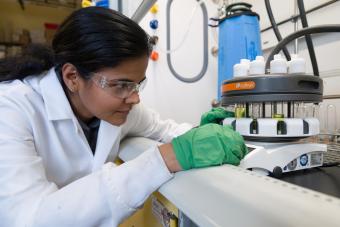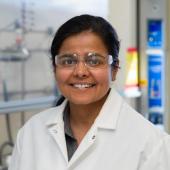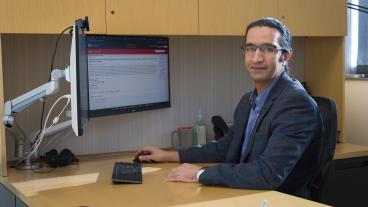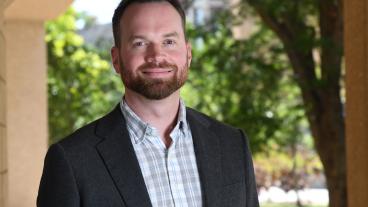Chemical and biological engineering faculty win NIH grants for early career investigators

Two Colorado School of Mines researchers – Alexander Pak and Ramya Kumar – have won the National Institute of General Medical Sciences Maximizing Investigator’s Research Award (MIRA) for Early Stage Investigators. Both Kumar and Pak are assistant professors of chemical and biological engineering at Mines.
This is the first time Mines researchers have won the National Institutes of Health’s prestigious MIRA, a grant specifically designed to provide promising early career researchers with a stable and flexible funding source to drive innovation and scientific breakthroughs in basic biological and medical science.
“We are proud to see Mines researchers earning this distinction,” said Walter G. Copan, Vice President of Research and Technology Transfer at Mines. “The MIRA recognizes these researchers and the promise of their ideas and investigative methods to drive innovation and create meaningful impact in advancing health and wellness.”
Studying the tiny biological machines inside cells

Pak has been awarded $1.7 million for five years to explore how proteins come together to form complex structures inside and around cells. These structures, called protein complexes, are made up of hundreds to thousands of proteins and act like tiny biological machines that perform a number of different functions, some of which are vital to human health.
Traditionally, research has focused on the static structures of protein complexes. Yet many protein complexes are dynamic, changing their shapes and functions in response to environmental changes, which makes them difficult to study.
Pak’s research aims to understand the formation, movementand function of these tiny dynamic machines. To accomplish this, Pak’s team will develop advanced computer models and tools to simulate and study two types of protein families that are found in bacteria: S-layers and microcompartments. Using these protein complexes as models, the team hopes to uncover new insights into how bacteria build these functional structures in response to environmental signals, which could one day lead to better treatments for infections and new tools for biotechnology.
“Nature has evolved astonishing ways to build complex and responsive molecular machines from simple protein building blocks,” said Pak. “Our team is fascinated by how bacteria organize these structures – how they grow, change and adapt based on the needs of the organism. To uncover these mechanisms, we develop new tools to push the capabilities of computer simulations. While we focus on bacterial systems, the methods and insights we gain have the potential to transform how we study protein-based structures across biology and how we design new protein-based biotechnologies.”
Since joining Mines in 2021, Pak and his team have studied how molecules organize themselves across space and time by using advanced computer modeling and simulation methods. Pak’s research is supported by the National Science Foundation and the National Institutes of Health. Prior to joining Mines, Pak was supported by the Ruth L. Kirschstein National Research Service Award for his postdoctoral training at the University of Chicago, where he studied the dynamics of viral protein complexes.
Improving our understanding of how cells respond to infection, disease and stress

Kumar has been awarded $2 million for a four-year period to support her vision of designing biofunctional polymer coatings that mimic naturally occurring chemical signals that determine cellular responses to infection, disease, or stress in the human body. These signals cause responses in our macrophages, which are immune cells that promote healing and fight infections but can also cause chronic diseases under certain circumstances.
Kumar’s research focuses on creating special ultra-thin coatings called polymer brushes that can display biochemical signals in precise ways, mimicking how they appear in the body. By changing the type, amount and placement of these signals, researchers can see how macrophages react and adapt in different situations.
The goal of Kumar’s research is to uncover how the identity, density and arrangement of these signals influence macrophage immune cells to take on different roles and behaviors, especially in complex environments like wounds or tumors. In the future, these tools could be used to study other important cell behaviors, like how stem cells grow or how other immune cells, such as T-cells, respond to disease.
“Macrophage polarization underpins everything from aging-induced inflammation to defending against cancer to wound healing. Macrophages are exquisitely sensitive to the surface chemistry they encounter,” Kumar said. “By designing a new method that uses thin polymer coatings to mimic our natural biology, my team can study the chemical signals that cause macrophages to become inflammatory.”
“Right now, we don’t fully understand how macrophages respond to environmental changes, which means we are limited in devising therapies for many chronic diseases,” said Kumar. “This research could lead us to the answers.”
A member of the Mines faculty since 2022, Kumar won a trifecta of early-career awards in 2025. In addition to winning the MIRA, she was previously awarded the National Science Foundation CAREER Award and the NIH’s National Institute of Biomedical Imaging and Bioengineering Trailblazer Award (R21). Kumar is the first Mines researcher to receive the Trailblazer, an award for early-stage investigators to pursue life science research that intersects with engineering and the physical sciences.
“The MIRA is a highly competitive award, and to have two faculty members in our department win it in the same year is extraordinary,” said Nanette Boyle, department head of chemical and biological engineering at Mines. “These awards recognize the creativity and vision that Dr. Kumar and Dr. Pak each bring to their research. The flexibility of MIRA funding will allow them to explore bold new directions and establish strong, independent research programs here at Mines—work that not only advances fundamental biological science but also reflects the interdisciplinary innovation that defines our department.”




